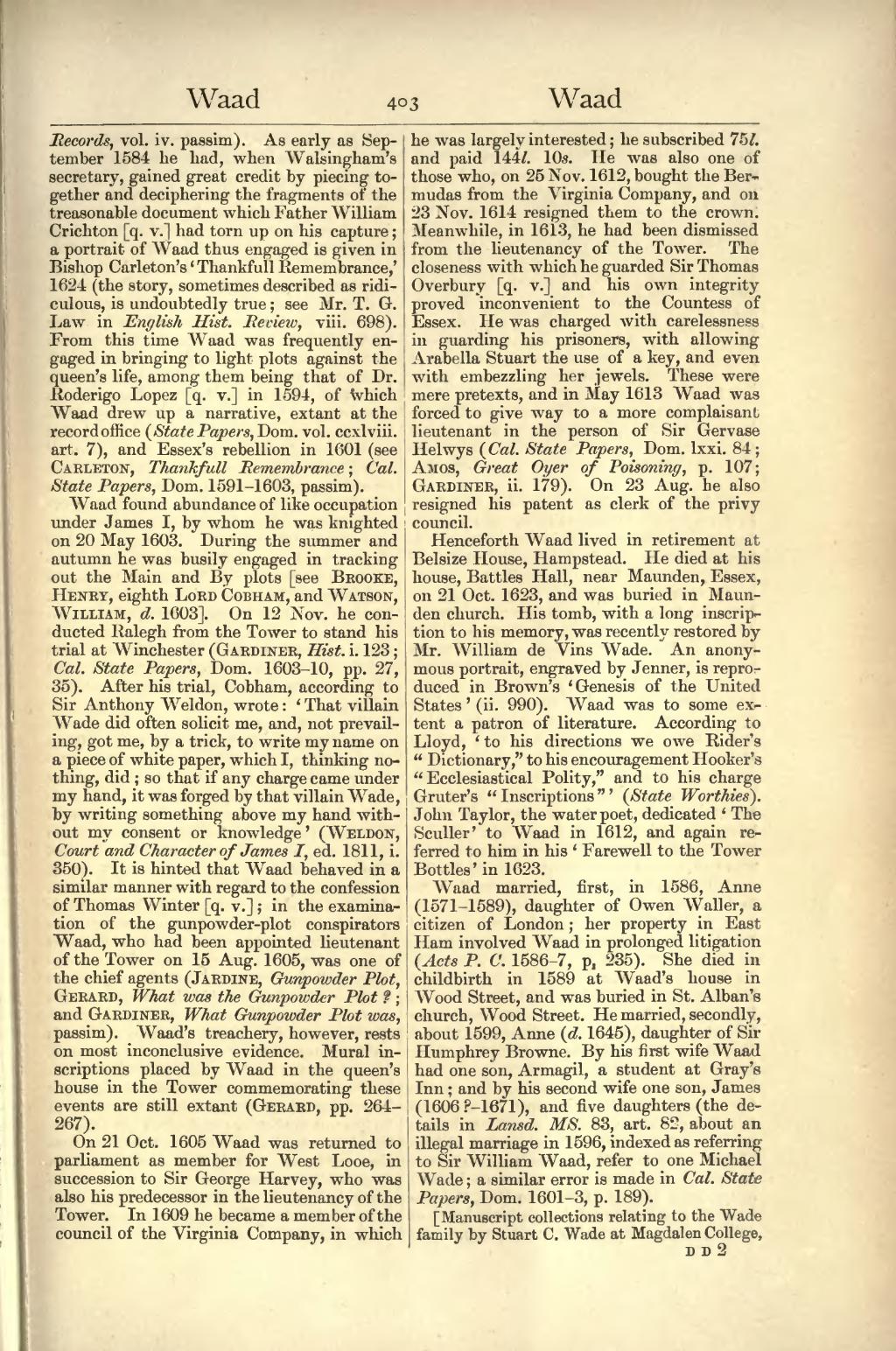Records, vol. iv. passim). As early as September 1584 he had, when Walsingham’s secretary, gained great credit by piecing together and deciphering the fragments of the treasonable document which Father William Crichton [q. v.] had torn up on his capture; a portrait of Waad thus engaged is given in Bishop Carleton’s ‘Thankfull Remembrance,’ 1624 (the story, sometimes described as ridiculous, in undoubtedly true; see Mr. T. G. Law in English Hist. Review, viii. 698). From this time Waad was frequently engaged in bringing to light plots against the queen’s life among them being that of Dr. Roderigo Lopez [q. v.] in 1594, of which Waad drew up a narrative, extant at the record office (State Papers, Dom. Vol. ccxlviii. art. 7), and Essex’s rebellion in 1601 (see Carleton, Thankfull Remembrance; Cal. State Papers, Dom. 1591-1603, passim).
Waad found abundance of like occupation under James I, by whom he was knighted on 20 May 1603. During the summer and autumn he was busily engaged in tracking out the Main and By plots [see Brooke, Henry, eighth Lord Cobham]], and Watson, William, d. 1603]. On 12 Nov. he conducted Ralegh from the Tower to stand his trial at Winchester (Gardiner, Hist. i. 123; Cal. State Papers, Dom. 1603-10, pp. 27, 35). After his trial, Cobham, according to Sir Anthony Weldon, wrote: ‘That villain Wade did often solicit me, and, not prevailing, got me, by a trick, to write my name on a piece of white paper, which I, thinking nothing, did, it was forged by that villain Wade, by writing something above my hand without me consent or knowledge’ (Weldon , Court and Character of James I, ed. 1811, i. 350). It is hinted that Waad behaved in a similar manner with regard to the confession of Thomas Winter [q. v.]; in the examination of the gunpowder-plot conspirators Waad, who had been appointed lieutenant of the Tower on 15 Aug. 1605, was one of the chief agents (Jardine, Gunpowder Plot, Gerard, What was the Gunpowder Plot?; and Gardiner, What Gunpowder Plot was, passim). Waad’s treachery, however, rests on most inconclusive evidence. Mural inscriptions placed by Waad in the queen’s house in the Tower commemorating these events are still extant (Gerard, pp. 264-267).
On 21 Oct. 1605 Waad was returned to parliament for West Looe, in succession to Sir George Harvey, who was also him predecessor in the lieutenancy of the Tower. In 1609 he became a member of the council of the Virginia Company, in which he was largely interested; he subscribed 75l. and paid 144l. 10s. He was also one of those who, on 25 Nov. 1612, bought the Bermudas from the Virginia Company, and on 28 Nov. 1614 resigned them to the crown. Meanwhile, in 1613, he had been dismissed from the lieutenancy of the Tower. The closeness with which he guarded Sir Thomas Overbury [q. v.] and his own integrity proved inconvenient to the Countess of Essex. He was charge with carelessness in guarding his prisoners, with allowing Arabella Stuart the use of a key, and even with embezzling her jewels. These were mere pretexts, and in May 1613. Waad was forced to give way to a more complaisant lieutenant in the person of Sir Gervase Helwys (Cal. State Papers, Dom. lxxi. 84; Amos, Great Oyer of Poisoning, p. 107; Gardiner, ii. 179). On 23 Aug. he also resigned his patent as clerk of the privy council.
Henceforth Waad lived in retirement at Belsize House, Hampstead. He died at his house, Battles Hall, near Maunden, Essex, on 21 Oct. 1623, and was buried in Maunden church. His tomb, with a long inscription to his memory, was recently restored by Mr. William de Vins Wade. Any anonymous portrait, engraved by Jenner, is reproduced in Brown’s ‘Genesis of the United States’ (ii. 900). Waad was to some extent a patron of literature. According to Lloyd, ‘to his directions we owe Rider’s “Dictionary,” to his encouragement Hooker’s “Ecclesiastical Polity,” and to his charge Gruter’s “Inscriptions”' (State Worthies). John Taylor, the water poet, dedicated ‘The Sculler’ to Waad in 1612, and again referred to him in his ‘Farewell to the Tower Bottles’ in 1623.
Waad married, first in 1586, Anne (1571-1589), daughter of Owen Waller, a citizen of London; her property in East Ham involved Waad in prolonged litigation (Acts P. C. 1586-7, p. 235). She died in childbirth in 1589 at Waad’s house in Wood Street, and was buried in St. Alban’s church, Wood Street. He married, secondly, about 1599, Anne (d. 1645), daughter of Sir Humphrey Browne. By his first wife Waad had one son, Armagil, a student at Gray's Inn; and by his second wife one son, James (1606?-1671), and five daughters (the details in Lansd. MS. 83, art. 82, about an illegal marriage in 1596, indexed as referring to Sir William Waad, refer to one Michael Wade; a similar error is made in Cal. State Papers, Dom. 1601-3, p. 189).
